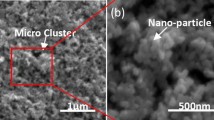Abstract
This paper investigates a theoretical prediction of friction drag reduction in turbulent channel flow which is achieved by using superhydrophobic surfaces. The effect of the hydrophobic surface is considered to be a slip boundary condition on the wall, and this new boundary condition is added to Large Eddy Simulation (LES) equations. The predicted drag reduction at Re τ = 180 is approximately 30%, which concurs with results obtained from Direct Numerical Simulation (DNS). An important implication of the present finding is that the near-wall turbulence structures are modified with streamwise slip velocity. In addition, a noticeable effect on the turbulence structure occurs when the slip length is greater than a certain value.
Similar content being viewed by others
References
MCCORMICK M. E., BHATTACHARYYA R. Drag reduction of a submersible hull by electrolysis[J]. Naval Engineers Journal, 1973, 85(2): 11–16.
TOMS B. A. Some observation on the flow of linear polymer solution through straight tube at large Reynolds numbers[C]. Proc. 1st Int. Cong. On Rheology. Amsterdam, The Netherlands, 1948, 135–141.
SHAO X., LIN J. and WU Tao et al. Experimental research on drag reduction by polymer additives in a turbulent pipe flow[J]. The Canadian Journal of Chemical Engineering, 2002, 80(2): 293–298.
BECHERT D. W., BRUSE M. and HAGE W. et al. Experiments on drag-reducing surfaces and their optimization with an adjustable geometry[J]. Journal of Fluid Mechanics, 1997, 338: 59–87.
KIM J. Active control of turbulent boundary layers for drag reduction[J]. Lecture Notes in Physics, 1999, 529: 142–152.
TRETHEWAY D. C., MEINHART C. D. Apparent fluid slip at hydrophobic microchannel walls[J]. Physics of Fluids, 2002, 14(3): 9–12.
OU J., PEROT B. and ROTHSTEIN J. P. Laminar drag reduction in microchannels using superhydrophobic sur-faces[J]. Physics of Fluids, 2004, 16(12): 4635–4643.
JOSEPH P., COTTIN-BIZONNE C. and BENOIT J.-M. et al. Slippage of water past superhydrophobic carbon nanotube forests in microchannels[J]. Physical Review Letters, 2006, 97(15): 156104.
CHOI C.-H., WESTIN K. and JOHAN A. et al. Apparent slip flows in hydrophilic and hydrophobic micro-channels[J]. Physics of Fluids, 2003, 15(10): 2897–2902.
MIN T., KIM J. Effects of hydrophobic surface on skin-friction drag[J]. Physics of Fluids, 2004, 16(7): 55–58.
YOU D., MOIN P. Effects of hydrophobic surfaces on the drag and lift of a circular cylinder[J]. Physics of Fluids, 2007, 19(8): 081701.
PIT R., HERVET H. and LÉGER L. Direct experimental evidence of slip in hexadecane: Solid inter-faces[J]. Physical Review Letters, 2000, 85(5): 980–983.
FUKAGATE K., KASAGI N. A theorical prediction of friction drag reduction in turbulent flow by superhydro-phobic surfaces[J]. Physics of Fluids, 2006, 18(5): 051703.
LI Ling, YUAN Ming-Shun. Modeling of drag reduction in turbulent channel flow with hydrophobic walls by Fvm method[J]. Acta Mechanica Sinica, 2011, 27(2): 200–207.
SMAGORINSKY J. General circulation experiments with the primitive equations: The basic experiment[J]. Monthly Weather Review, 1963, 91(3): 99–164.
GERMANO M., PIOMELLI U. and MOIN P. et al. A dynamic subgrid scale eddy-viscosity model[J]. Physics of Fluids A, 1991, 3(7): 1760–1765.
LILLY D. K. A proposed modification of the Germano subgrid-scale closure method[J]. Physics of Fluids A, 1992, 4(3): 633–635.
Author information
Authors and Affiliations
Corresponding author
Additional information
Biography: NOURI Nowrouz Mohammad (1959-), Male, Ph. D., Associate Professor
Rights and permissions
About this article
Cite this article
Nouri, N.M., Sekhavat, S. & Mofidi, A. Drag Reduction in a Turbulent Channel Flow with Hydrophobic Wall. J Hydrodyn 24, 458–466 (2012). https://doi.org/10.1016/S1001-6058(11)60267-9
Received:
Revised:
Published:
Issue Date:
DOI: https://doi.org/10.1016/S1001-6058(11)60267-9




